

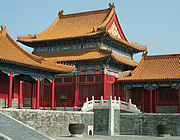
Beijing is a fascinating city with insights into the lives of the cosseted Emperors in the Forbidden City, and the ordinary people in the hutongs, fine temples and parks where Tai Chi is a morning staple. Absolute highlight was the Cricket Man on our second visit in 2019.
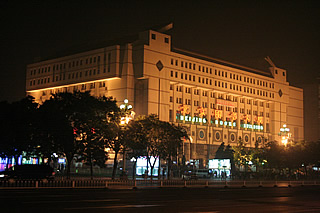
In 2016 we stayed at the Xidan, a manageable walk from Tian'anmen Square (and very good food!) - on the way we passed the Beijing Books Building - an enormous block of a building, 6 floors crammed with books! The building is very typical of the "blocky" type of architecture in Beijing.
Inside it was very busy and many people, including lots of children, were sitting around on the floors just reading.
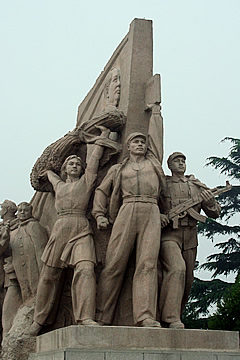
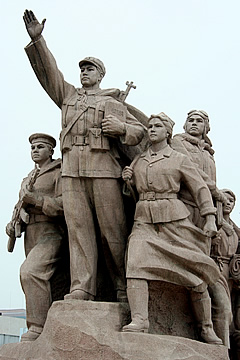
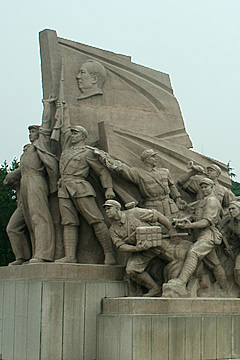
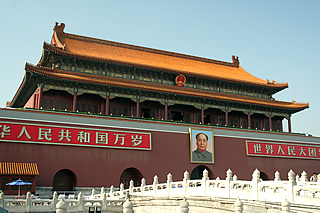
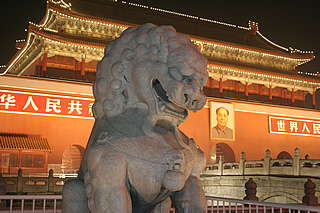
Our first guided visit was next morning to Tian'anmen Square: truly vast but singularly uninspiring - too big, I think. At the south end is the Chairman Mao Memorial Hall with wonderful heroic figures at all four corners.
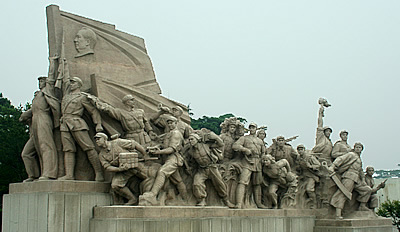
It was smoggy here, and very hazy.We returned a few days later to take more photographs on a clearer day.
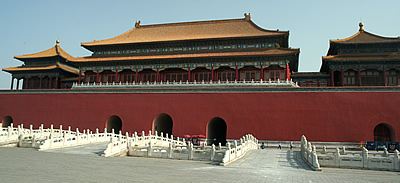
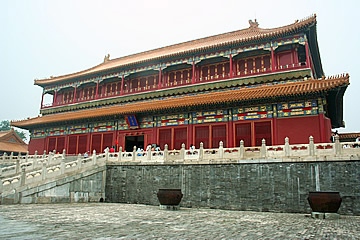
The Forbidden City, palatial home to the emperors, is again vast - nothing is on a small scale here it seems! Reputed to have 9000 chambers its name derives from the Chinese people being forbidden to approach even the walls of the complex. Begun in the reign of Kublai Khan - descendant of Genghis Khan - in the thirteenth century, the buildings today date mainly from the fifteenth century Ming dynasty. It is built to a rigid geometric plan at the centre of a city considered to be the centre of the universe.
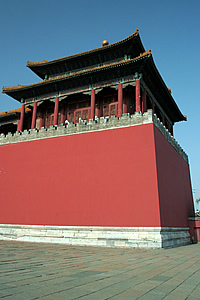
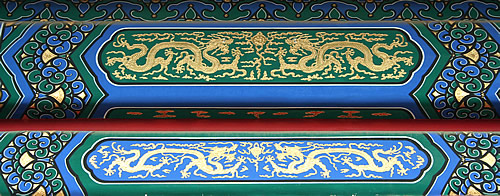
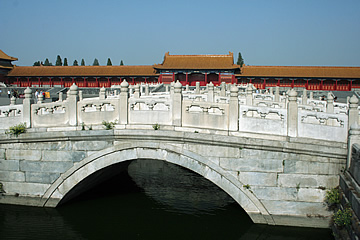
One or two of the buildings were under wraps being renovated/decorated for the Olympics in 2008 but most were finished, with the bonus that everything was pristine. The colours are fabulous - mostly blues, greens and gold set off by the dull red painted walls.
The buildings are set on a high red-walled base to give an impression of power. Visitors are not actually allowed into any of the buildings but several interiors can be seen from the outside, including the throne room. The Imperial yellow silk shines out in the dimmest interiors.
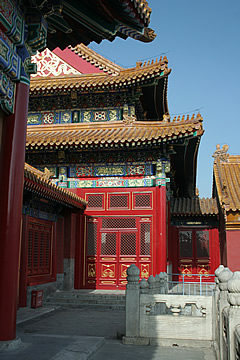
The layout is a symmetrical succession of courtyards with red-walled, yellow-roofed buildings on all sides. The Golden Water canal winds through the complex, crossed by pristine white bridges. the whole complex being enclosed within a rectangular moat.
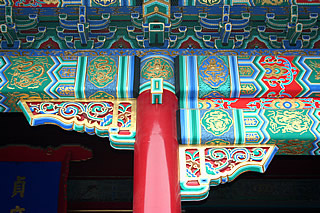
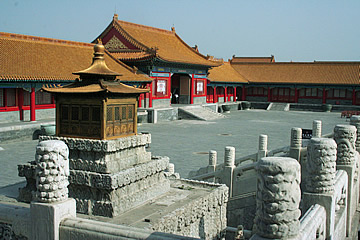
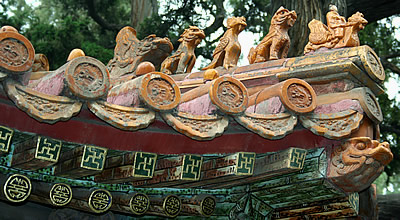
The corners of the roofs are occupied by a procession of figures - the more numerous they are, the more important the building.
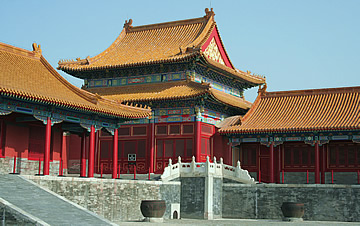
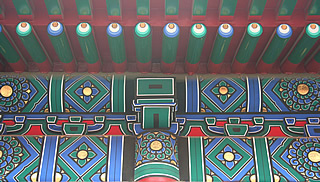
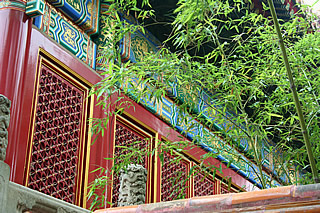
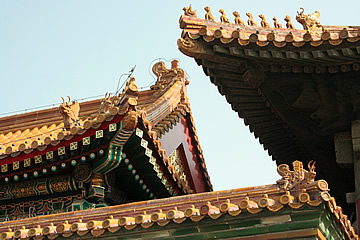
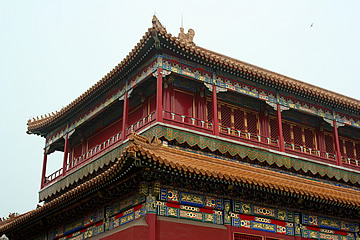
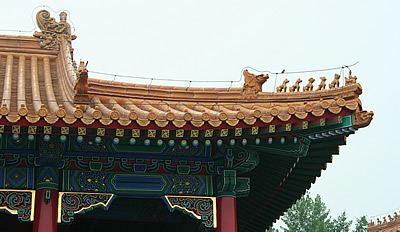
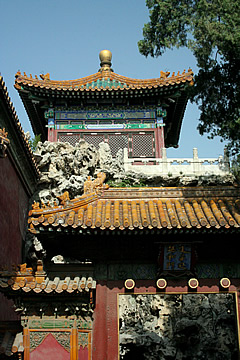
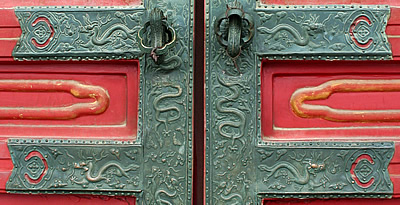
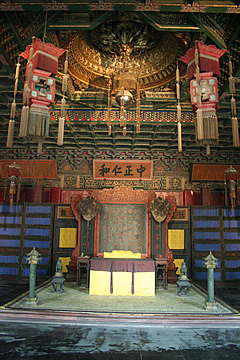
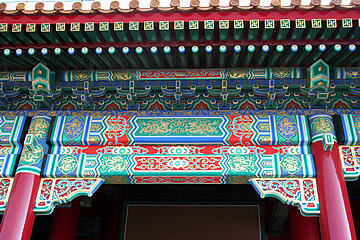
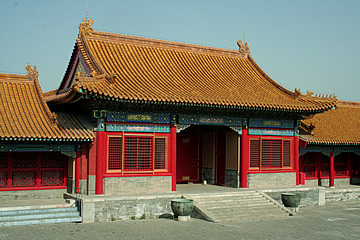
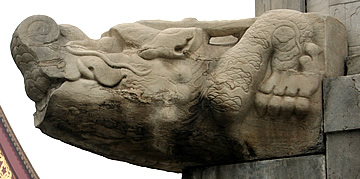
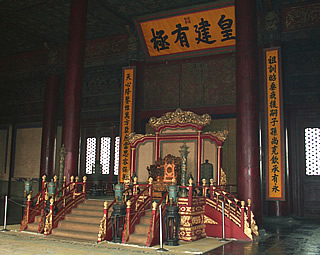
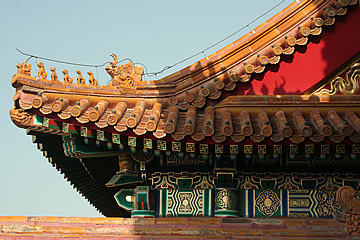

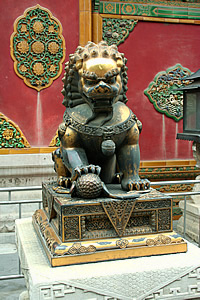
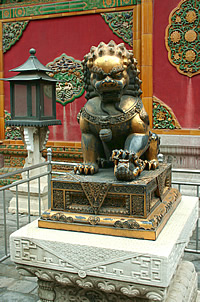
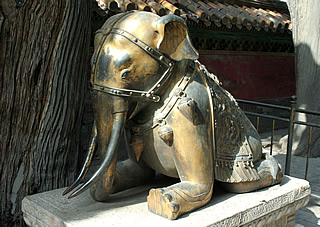
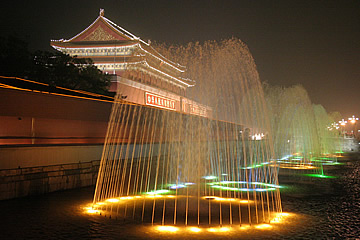
Later, on our own, we took the subway to the south gate of Tian'anmen Square and wandered through the hutongs - apparently these are in danger of being completely wiped out in order not to present a poor impression come Olympics time.
This is a shame, because these are fascinating places, more really Chinese than anything we have yet seen. Here are the people, in their shops and stores - selling everything from slippers to silks (or maybe not!). In 2019 we returned to Beijing and revisited what remained of the hutongs.
One evening we returned to Tian'anmen Square and the Forbidden City was lit up and the fountains were illuminated with coloured lights - very beautiful.



We returned to Beijing in 2019 and tried to revisit Tian'anmen Square but it was impossible to get to from the east side without queuing at very crowded checkpoints. We'd already been stopped on the north side of the road and directed onto the south side - admittedly by a bunch of very friendly police. The number of cameras everywhere was a bit intimidating - many more than we'd seen on our first visit. Some roadside posts had multiple cameras including the spherical swivelling kind which I find very sinister. Security for the 70th anniversary celebrations was extremely tight.
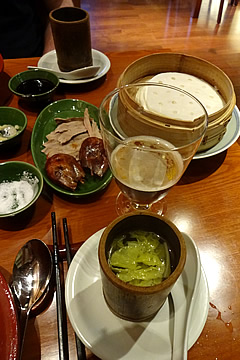
We had superb Peking Duck at the Grand Hyatt. It was served with cucumber and spring onion strips, soy, sugar and garlic, and a duck soup which was slowly cooked for four hours.
The duck was expertly carved at our table. Cooked in a wood-fired oven for particularly crisp skin which was eaten with sugar and literally melted in the mouth.


The soy sauce and garlic were for the duck meat - we both settled on the soy sauce on the meat in the lovely thin pancakes - absolute heaven.
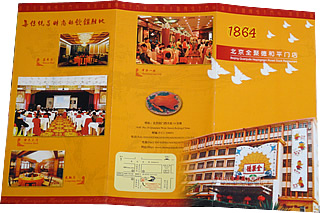
We had some really good food in Beijing in 2007 - in our hotel, restaurants and in a family home, which we were a bit apprehensive about, but we needn't have worried. This was run by the family, a lunch time spot for Chinese as well as tourists, and the food was excellent. We variously had, throughout our stay in Beijing, dim sum, king prawns, duck (and other meats) freshly griddled to order at the hotel, pork ribs, squid, meat balls, fried aubergine. Not to our liking is tofu and one or two vegetable dishes.
The Beijing Quanjude Hepingmen Roast Duck Restaurant was, I think, top of our list. Vast is, again, the only word to describe this place, 15000 square metres of dining including banquet halls and more than 40 separate dining rooms.
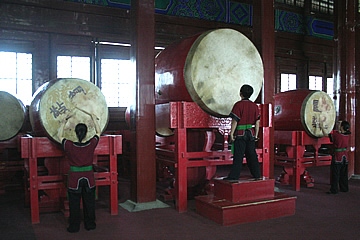
It's impossible not to have the Peking Duck. Wonderful pancakes with plum sauce and fabulous roast duck carved at the table.
The Drum Tower in Beijing is well worth a visit, especially if there is drumming going on! The drumming was fantastic, apparently an ancient method of letting the citizens know the time!
A kindergarten was on our schedule too, to learn a little about early education, but the children were all asleep - very sweet.
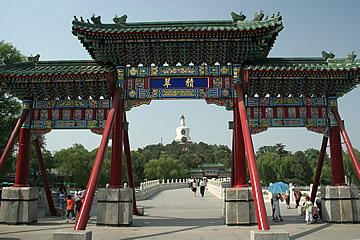
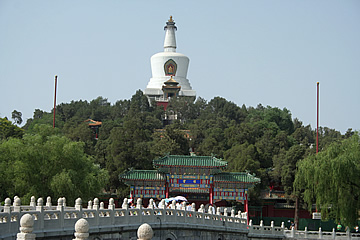
Huge Beihai Park is pleasant to wander through and is curious for the white dagoba, built in the seventeenth century to commemorate a visit of the Dalai Lama.
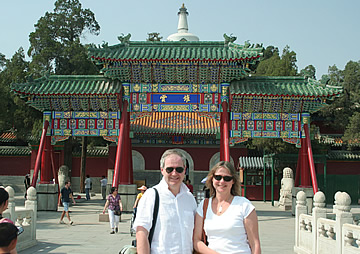
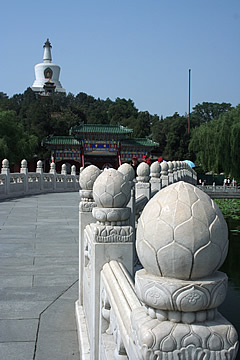
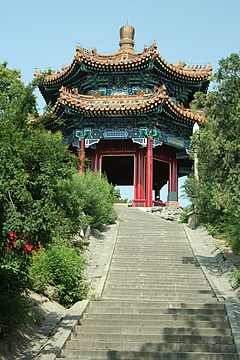
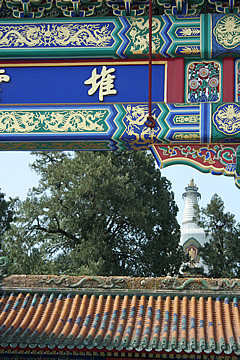
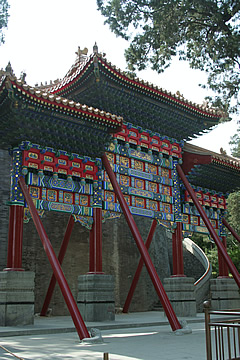
East of Beihai is Jingshan Park - created from the spoil from digging the palace moat. From the top of the hill here the views over the Forbidden City are very good; though a rather flat perspective it does give a good idea of the huge scale of the place.
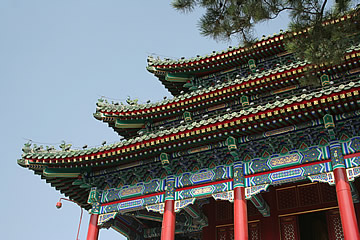
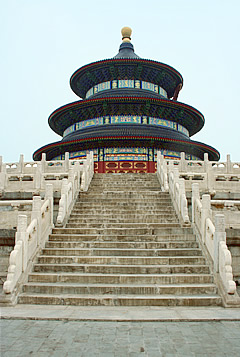
The Ming Dynasty Temple of Heaven, freshly painted, is another beautifully colourful structure regarded by many as the supreme example of Ming design.
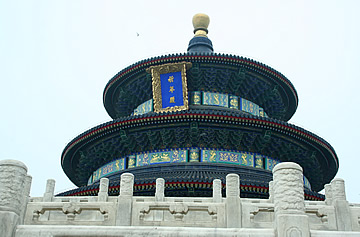
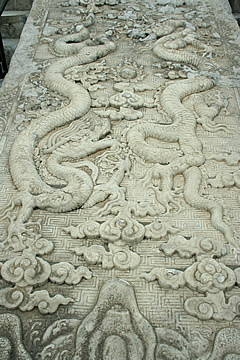
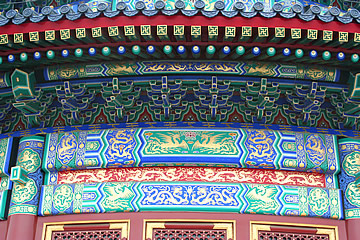
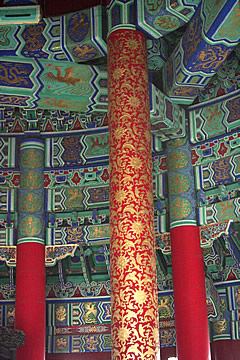
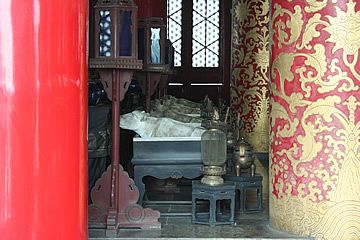
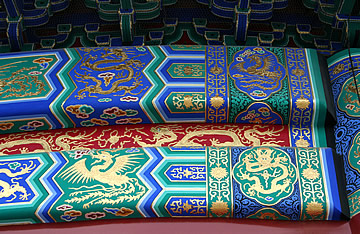
Heaven was considered to be round and the earth square, so the round temple sits on a square platform.
The Temple is, amazingly, built entirely of wood without the use of a single nail!
Cows were ritually slaughtered here, hence the cow statues inside.
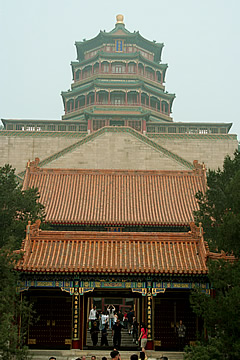
The Summer Palace is another beautiful spot to wander, very much the creation of the notorious Empress Dowager Cixi. She was infamous for many things, including creating a huge marble boat (which remains at the summer palace) with funds originally destined for the navy! Though the superstructure is wooden the hull is solid marble.
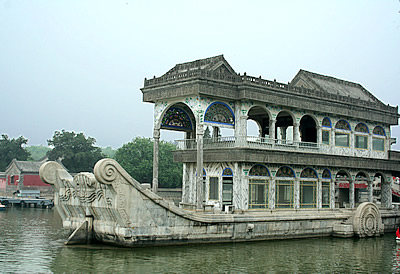
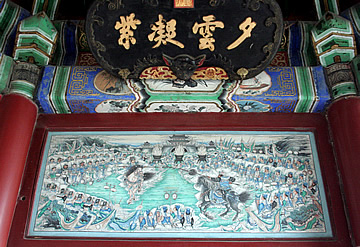
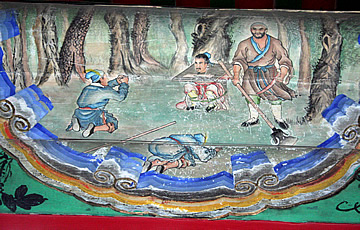
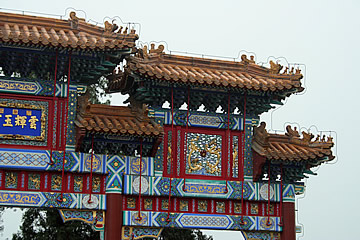
The 900m Long Gallery, decorated with paintings over its entire length, is said to have been built so that Cixi could walk outside even in poor weather.
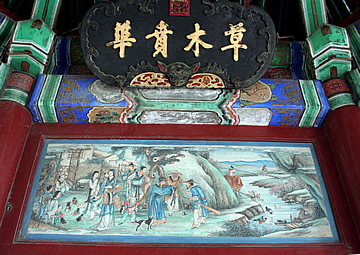
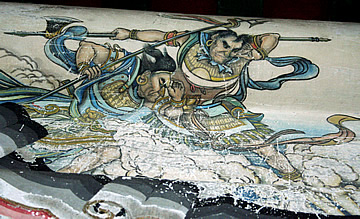
De rigueur to take a Dragon Boat across the lake which has a beautiful seventeen arch bridge, though too hazy that day for a decent photograph.
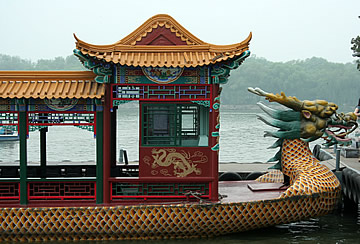
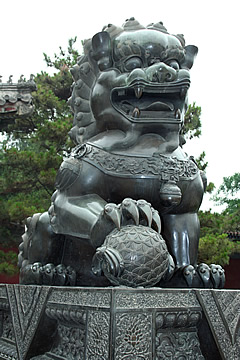
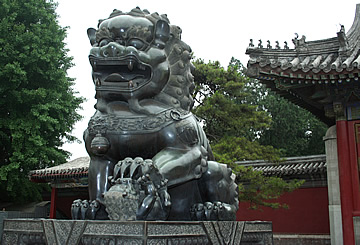
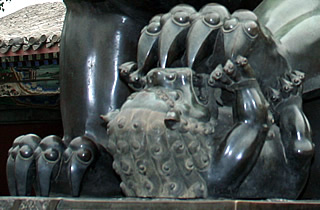



In 2019, when we returned to Beijing, we made a point of asking to go into the hutongs, to see how much had changed.
Our guide wandered with us explaining how these are now very much sought-after places to live - many of the more opulent ones, closest to the Forbidden City, have always been the homes of rich merchants and officials. Those further away belonged to the less well-off - artisans, craftsmen, labourers. A drum outside the door signifies the owner was a civil servant, lions for the military.
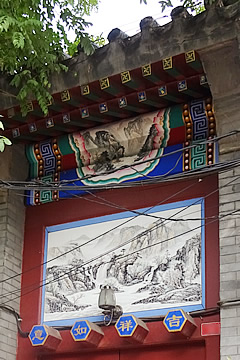
The street frontage of the homes leads to a courtyard dwelling, no gardens as such but lots of plants in all kinds of containers.


There is one extremely commercial street, lined with tourist shops, which we couldn't get out of fast enough! Sadly the touristy nature came from good intentions. Originally the street was called Gulou Byway but during the late Qing Dynasty (1644-1911) it was renamed "Yandai" which means "tobacco pipe", probably because many shops sold smoking sets. It was given protected status as embodying traditional customs and features and restored and in 2007 designated a Specialty Shopping Street.


Away from this street the narrow lanes were very peaceful and quiet and we enjoyed strolling and just observing local life and architecture. In 2007 we'd visited by rickshaw but walking is much better.



We continued through the hutongs to the Bell and Drum Towers standing at each end of a tree-lined plaza.
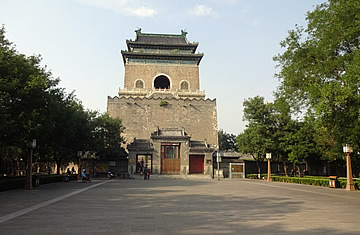
Here we were met by a second guide who took us deep into the hutongs to a family home where we tried our hand at a bit of theatrical mask painting while we waited for the Cricket Man.


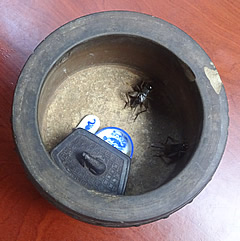

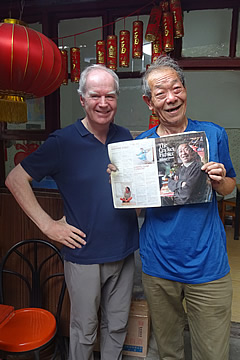
This amazing 70 year old man enthusiastically told us about the sport of cricket fighting. The sport is still practiced and often involves gambling.



The Cricket Man doesn't have a word of English so our guide translated as best he could.
He treats his crickets with great tenderness and no harm seems to come to them in the fight. They have their own home in a ceramic pot with tiny bowls for food and water and a covered bed.

When it dies the fighting cricket is placed in a casket - the more illustrious the fighter the more elaborate the casket!
Of everything we saw in Beijing, the Cricket Man was my favourite, such a character.